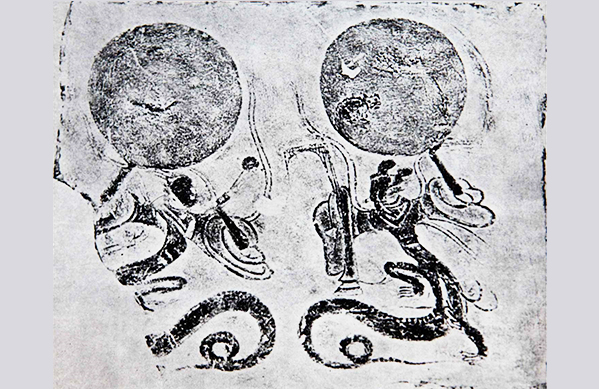Fuxi and Nüwa

FILE PHOTO: A rubbing of a Han Dynasty stone relief with the image of Fuxi (left) and Nüwa (right)
The myths of Fuxi and Nüwa have spread far and wide to almost all regions and among all ethnic groups in China. According to Classic of Mountains and Seas, a goddess named Huaxu became pregnant with twins Fuxi and Nüwa after stepping into a giant footprint. Therefore, Fuxi and Nüwa are generally believed to be siblings.
Fuxi holds the legendary status as the founder of the Chinese people and the first mythical emperor of China. He is also credited for the creation of writing, the establishment of marriage customs, and inventing the Chinese trigrams known as “Bagua.”
In most cases, Nüwa is credited with creating humanity by molding figures from yellow clay and bestowing them with life, as well as restoring the pillars of Heaven. According to some ancient texts such as Huainanzi, a fierce battle between deities shattered the pillars supporting Heaven, leading to catastrophic flooding and the collapse of the celestial domain. Nüwa patched the holes in Heaven with molten “five-colored stones,” and used the sturdy legs of a tortoise to mend the pillars. The worship of Nüwa is likely derived from female worship in primitive matrilineal societies. The legends surrounding her mending of Heaven possibly reflect the history of matriarchal society, in which large-scale flood control projects were undertaken under the leadership of female rulers.
The myths of the marriage of Fuxi and Nüwa only emerged since the Han Dynasty. According to Duyi Zhi, a Tang Dynasty text, Nüwa lived with her older brother when the world first began, and humans had not yet come into being. The siblings contemplated becoming husband and wife, but felt ashamed. Seeking a sign of approval, they asked Mount Kunlun to cause a misty vapor to appear if they were allowed to mate with each other. At this, a misty vapor immediately gathered. When the sister became the wife of her brother, they fashioned a grass fan to conceal their faces, still burdened by shame. Since the Han era, depictions of Fuxi and Nüwa often portray them with intertwined, snake-like tails, with Nüwa holding compasses (gui) and Fuxi holding a square (ju, used to mark 90-degree angles), denoting that they had laid down the laws of humanity. Today, the phrase “gui-ju” is used to signify “the way things should be.”
Edited by REN GUANHONG
